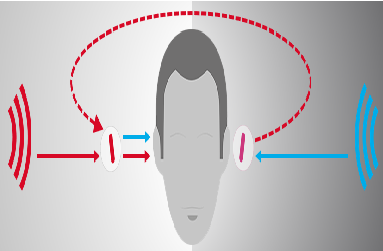Hear all about it.

Why a Quiet Environment Matters for Hearing Tests
When it comes to testing hearing, accuracy is everything. Even in what we perceive as a “quiet” room, there can be enough background noise to interfere with test results. That’s why a properly controlled environment, such as a soundproof booth, is essential for a reliable hearing assessment.
In this blog, we’ll explore what qualifies as a "quiet" room, how background noise can impact hearing tests, and why soundproof booths make all the difference.

ABR Testing: What It Is and Why It’s Important
Auditory Brainstem Response (ABR) testing is a crucial tool in audiology, allowing clinicians to assess hearing and neurological function in people of all ages. Whether used for new-born hearing screenings, diagnosing auditory disorders, or identifying nerve-related hearing issues, ABR testing plays a vital role in understanding how sound travels from the ear to the brain.



Bone Anchored Hearing Aids (BAHA): How They Work and Who They Help
For individuals with certain types of hearing loss, traditional hearing aids might not be the best solution. That’s where Bone Anchored Hearing Aids (BAHA) come in—a specialised hearing solution that uses bone conduction to transmit sound. In this blog, we’ll explore what BAHAs are, how they work, who can benefit from them, and what the process of getting one involves.

Cochlear Implants: Restoring Sound, Transforming Lives
Hearing loss can significantly impact one’s ability to communicate, engage socially, and enjoy the sounds of the world. For individuals with severe to profound hearing loss who gain little benefit from traditional hearing aids, cochlear implants offer a life-changing solution. In this blog, we’ll explore what cochlear implants are, how they work, and who can benefit from this incredible technology.

The Range of Human Hearing: Exploring the Limits and Changes Over Time
The human ear is an extraordinary organ, capable of detecting a wide range of frequencies. On average, humans can hear sounds between 20 Hz and 20,000 Hz—a range that covers the deep rumble of thunder to the high-pitched chirping of birds. However, not everyone hears these frequencies equally, and age plays a significant role in how our hearing changes over time.

Ears Are Self-Cleaning: How Earwax Protects and Maintains Ear Health
Our ears have a natural and effective self-cleaning mechanism, primarily thanks to earwax, or cerumen. While earwax often gets a bad rap for being “dirty” or something that needs frequent removal, it actually plays a crucial role in ear health by keeping the ear canal clean and protected. Here’s a closer look at how this process works and why you shouldn’t be too quick to reach for cotton buds.

Neural Plasticity and its role in Acclimatising to New Hearing Aids
When someone is fitted with new hearing aids, especially for the first time, the transition can feel overwhelming. Many sounds that may have been missing for years are suddenly reintroduced, which can initially feel disorienting. This adjustment process is where the brain’s remarkable ability to adapt comes into play, and this is largely thanks to something called neural plasticity.
In this blog, we’ll dive into what neural plasticity is and how it plays a crucial role in helping you acclimatise to new hearing aids and improve your overall hearing experience.

Does Hearing Loss Affect Balance?
Many people are familiar with the role our ears play in hearing, but did you know that they are also essential for maintaining balance? In fact, the ear is responsible for much more than just picking up sound—it plays a crucial role in helping us stay upright and oriented in the world. So, does hearing loss affect balance? The answer is yes, it can. Let’s dive into how these systems are connected and how hearing loss might impact your stability.

Why Do I Need Two Hearing Aids? Understanding the Benefits of Binaural Hearing
When it comes to addressing hearing loss, one of the most common questions we receive at High Peak Hearing is, "Why do I need two hearing aids?" It’s a fair question, especially if one ear seems to have more significant hearing loss than the other. However, the truth is that our brain is wired to hear with two ears, a process known as binaural hearing, and fitting two hearing aids can vastly improve your auditory experience. Let’s break down why two hearing aids are typically recommended and how modern technology has made them even more powerful.

Update on Apple: From Earbuds to Hearing Aids?
As predicted by High Peak Hearing back in April, Apple has introduced a new hearing aid mode in its AirPods Pro 2, a feature aimed at making technology more accessible for those with mild to moderate hearing loss. This innovation signifies yet another step in Apple’s mission to merge cutting-edge tech with accessibility, and it’s an exciting development for anyone in the audiology or hearing care world.

The Glorious Complexity of Audiology: Embracing the Uniqueness of Every Patient
In the world of audiology, there's a beautifully complex truth that often goes unnoticed: no two patients are the same. Even when two individuals have similar hearing test results on paper, their journeys through hearing loss and their experiences with sound are often vastly different. This complexity makes audiology not just a science but an art—one that requires a deep understanding of human diversity and a commitment to bespoke care.

Recognising the First Signs of Hearing Loss
Hearing loss can be a gradual process, often going unnoticed until it significantly impacts daily life. Being aware of the early signs of hearing loss can lead to timely intervention and better outcomes for your hearing health. In this blog post, we'll explore the initial indicators of hearing loss and the importance of seeking professional help as soon as they are noticed.

New Study Reveals Higher Rates of Hearing Loss in the UK
Researchers from the universities of Manchester and Nottingham have found that over a quarter of the UK population is estimated to have some form of hearing loss. This new analysis indicates that about 18 million people are affected, which is six million more than previous estimates.

Understanding CROS and BiCROS Hearing Aids for Single-Sided Deafness
Single-sided deafness (SSD) presents unique challenges, but modern technology offers effective solutions through CROS (Contralateral Routing of Signal) and BiCROS hearing aids. These devices enhance the hearing experience by addressing the specific needs of those with SSD.

NHS vs Private Hearing Aids: Understanding Your Options
When it comes to managing hearing loss, choosing the right hearing aid provider can significantly impact your quality of life. We are very lucky in the UK to have access to free hearing aids via the NHS. I have spent most of my career in the NHS; assessing patients, fitting hearing aids and supporting busy ENT clinics. However, there were many times when I was asked by a patient in the NHS, if I could recommend a private hearing aid audiologist.

Lifetime Aftercare: What Does It Actually Mean?
At High Peak Hearing, we believe in providing comprehensive support to our patients, not just during the initial purchase of hearing aids, but throughout their lifetime. We often mention our "lifetime aftercare" service, but what exactly does that entail? In this blog post, we aim to demystify what lifetime aftercare means for our valued hearing aid patients.

New Webstore
At High Peak Hearing, we're committed to providing you with the best possible hearing care solutions, and our online store is another step towards making your experience even more convenient and accessible.

Apple Are Entering The Audiology World
It is rumoured that Apple’s new AirPods Pro will reportedly gain ‘hearing aid mode’ with iOS18 in late 2024. So what does this mean for you?

